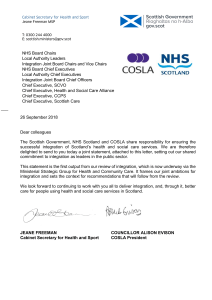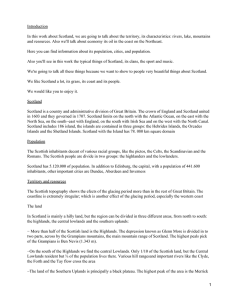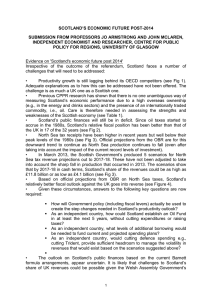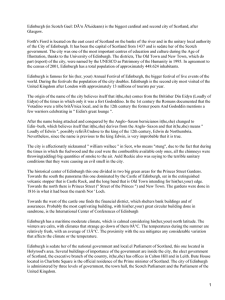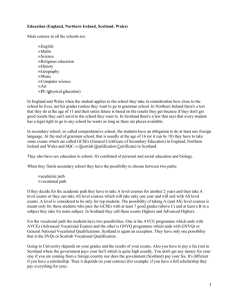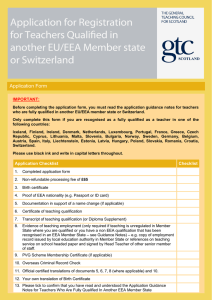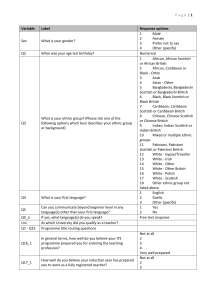CONTENTS Introduction . 2 Great Britain Capital London................. 3
Anuncio
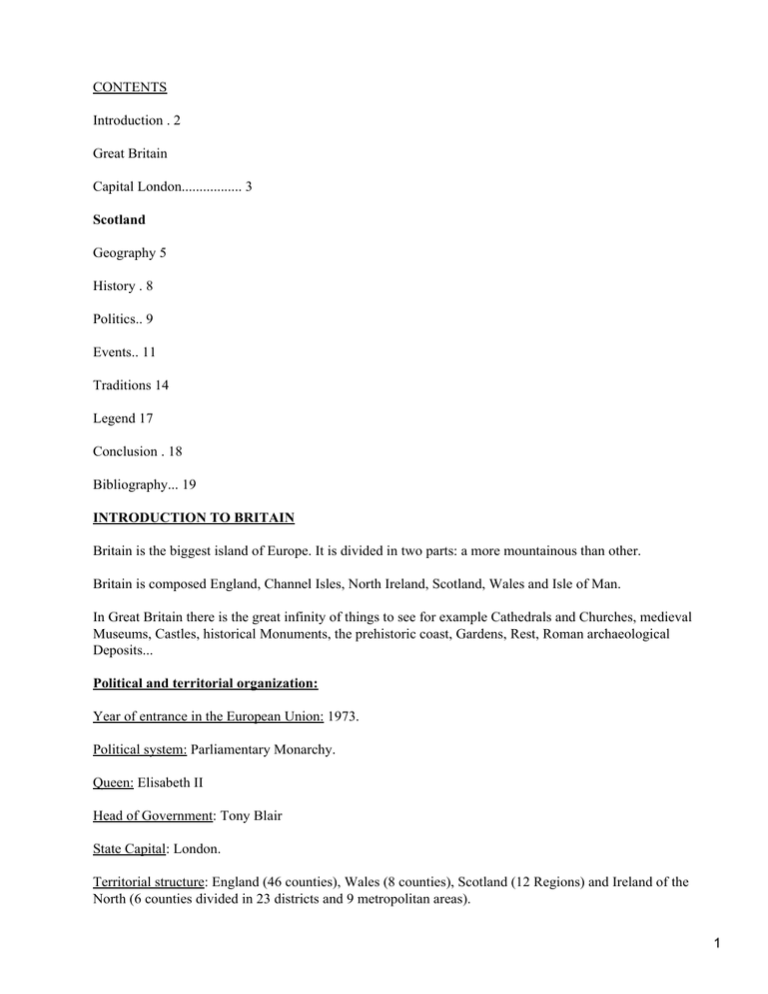
CONTENTS Introduction . 2 Great Britain Capital London................. 3 Scotland Geography 5 History . 8 Politics.. 9 Events.. 11 Traditions 14 Legend 17 Conclusion . 18 Bibliography... 19 INTRODUCTION TO BRITAIN Britain is the biggest island of Europe. It is divided in two parts: a more mountainous than other. Britain is composed England, Channel Isles, North Ireland, Scotland, Wales and Isle of Man. In Great Britain there is the great infinity of things to see for example Cathedrals and Churches, medieval Museums, Castles, historical Monuments, the prehistoric coast, Gardens, Rest, Roman archaeological Deposits... Political and territorial organization: Year of entrance in the European Union: 1973. Political system: Parliamentary Monarchy. Queen: Elisabeth II Head of Government: Tony Blair State Capital: London. Territorial structure: England (46 counties), Wales (8 counties), Scotland (12 Regions) and Ireland of the North (6 counties divided in 23 districts and 9 metropolitan areas). 1 Basic social statistics: Total population: 58, 48 million. Density of population: 244 hab/km2. Life expectancy: 78.1 years. Urban Population: 90 %. Religions: Anglicans (27 million), Catholics (9 million) and other minorities (Muslim, Presbyterians, Methodists, Sikh, Hindu, and Jews). Ethnic groups: English (81, 5 %), Scot (9, 6 %), Irish (2, 4 %), Wales (1, 9 %), etc. Official languages: English, Welsh (26 % of the population of Wales), Scot (60,000 in Scotland). CAPITAL OF GREAT BRITAIN LONDON London is the capital of England and the United Kingdom. Located to the south of Great Britain and borders of the Thames River, it was founded around year 43 by the Romans with the name of Londinium. Surface: 1.572 km² Population: 7.170.000 hab. Country: Great Britain Local time: GMT Telephone area code: 020 The places more important of London Big Ben Big Ben is a great clock; it is the familiar name that occurs him to the tower of the clock of the Palace of Westminster in London. The name, Big Ben is almost universally used to talk about to the clock of the tower. Nevertheless, officially, one talks about specifically to the main bell within the tower. The tower was raised like a part of a new palace designed by Charles Barry, after the old palace of Westminster was destroyed by the fire the night of the 16 of October of 1834. The tower is designed to the Victorian gothic style, and counts on 93,3 meters of height. Buckingham Palace The Buckingham Palace it has been the official residence of the British sovereigns from 1837 and belonged in century XVIII to the Dukes of Buckingham. Nowadays, it is the official house of the British monarchy and in her it lives Queen Isabel II and her family. 2 Until 1993, the palace had remained closed until the queen decided to open it to collect bottoms to repair the castle of Windsor, which had been destroyed due to a fire. From that then, during the summer the visitors to cross it, while the queen is of vacations in the castle of Balmorals, in Scotland. Hyde Park With 145 hectares, Hyde Park is the greater green space of London. During the summer, full of table cloths of picnic, people getting sunburned and families. The "Serpentine", a channel that crosses the park, can be sailed in boats. Every summer, the gallery of the park becomes the residence of an invited artist. During 2003, the Brazilian architect Oscar Niemeyer designed a whole pavilion. Hyde Park also is the pop seat of concerts of and rock during the sunniest months. Sundays in the morning, in the corner of Marble Arch the "Speaker's Corner" settles, an inherited tradition of serious disturb acnes happened in 1872. Cemetery of Hihgate Located at the top of Highgate Hill, this cemetery began to be constructed in 1839 and is a jewel of the Victorian funeral architecture. One is a true "city of deads", since in his interior they are buried 168,000 people, in approximately 52,000 tombs. It is divided in two sections, the West, older, and the East, connected by the way of Swain's Lane. In the route they will be put to find the tombs of famous personages for example Charles Dickens, Faraday, Karl Marx, George Eliot, and Radclyffe Hall. SCOTLAND GEOGRAPHY Scotland one is separated of England by Montes Cheviot and forms a geographic and historical unit. It is divided in two geographic areas: the low earth and the Scottish high earth. Scotland this formed by Stirling, Dumfries, Glenrothes, Stornoway, Inverness, Edinburgh, Kirkwall, Lerwick, Glasgow, Dundee and Aberdeen. Capital of Scotland is Edinburgh, one of the prettiest cities of the north of Europe, constituted by 790 islands Scotland has an extension of 81610km², approximately with a length of 441km of north to the south, and varying between 39 and 248km of the coast this to west. This country is one of the countries with smaller density of population of old Europe, it has 5,1million of habitants. For this reason, it is not difficult found with great uninhabited extensions. Scotland does not have a concrete national anthem. Especially they compete Flower of Scotland and Scotland the Brave. Second it is magnificent example of music pipe. First, Flower of Scotland seems goes way of being more official than the other. 3 THE MOST IMPORTANT CITIES OF SCOTLAND GLASGOW Glasgow is the greater city of Scotland, is next to the Clyde River. It is the populated city more and it is located to 71km to the West of Edinburgh, 55km to the Northeast of Ayr, and 232km southwestern of Aberdeen. The area of the city is 175, 1 km2. And several galleries and museums expose the work of artists like, for example, Charles Rennie Mackintosh. Glasgow has many places known by its cultures and monuments for example: • Science Centre Glasgow: It was built in downtown. It has four floors of scientific exhibition and the Glasgow tower, a thin structure that reaches the 440 feet of height with views to the Clyde River. There you will be able to see from the space to the North Pole. • Glasgow Cathedral: Cathedral in care of Historic Scotland, Church of Scotland Historic Building. Sunday services 1100 and 1830 hours. Very fine Cathedral with outstanding stained glass windows. Lower church is one of the chief glories of medieval Scottish architecture, contains Tomb of St Mungo, Patron Saint of Glasgow. 4 • The Valley Clyde: In the valley of Clyde is the valley of Paisley that gave its famous name bully−boys. The Clyde river happens next to Nuw Lanark, one old industrial colony of the century XVIII that comprises of the Patrimony of the Humanity. Clyde Waterbus is a cruise in boat, that you can to observe the beauties of the city or can also go to the opening of Greenock on board of a steamer. EDINBURGH Edinburgh is the capital of Scotland and second city in size after Glasgow. In Edinburgh the old helmet and the modern part are distinguished clearly. We can find in region of the Lothians, in low territories of Scotland, an especially interesting zone by the coast and the impressive landscape. Their more remarkable products are: paper, whiskey, electrical equipment and electronic, nourishing and chemical products. Edinburgh has many places known by its cultures and monuments for example: • Holyroodhouse Palace: It is located at the end of the Royal Mile and it is the official residence of the queen when it is in Scotland. The palace was originally the abbey Agustina de Holyrood and exist a legend about its foundation. • Edinburgh castle: The castle of Edinburgh is located on the nucleus of an extinct volcano. Edinburgh was not the capital of Scotland until the end of the Average Age, before that time, the capital was in the place in where the king and his cut were. In This Castle where St. Margaret died, shortly after finding out the death of its husband, King Malcolm III and his older son, in 1093. • St Giles Cathedral: Located in the Royal Mile, the cathedral of St. Giles dates from 1120, being of first importance in the history of Scotland. It was the church of John Knox. This beautiful building very is connected with the royalty and famous personages, and is remarkable by its beautiful show windows of colors. • Outlook Tower: Dark double bed, is a giant camera that catches an alive image and of the outer world. HISTORY From the megalithic circles of the Orca to the new building of the Parliament that is being constructed in Edinburgh, turbulent Scottish history includes a period of eight thousand years characterized by the invasion and independence, the war and the religious agitation, intrigue and the repression. But Scotland also would be witness of the blossoming of the imagination and the talent in many spheres of the field of the human persistence, thanks to which it got to occupy a privileged position, not only within the United Kingdom, but in Europe and the rest of the world? The qualification of the XIX Glasgow of second city of the British Empire is not a simple show. The history of the country has left track in the soul of its town, as well as in the landscape, and has contributed to a large extent to the inflamed pride with which the today Scot see themselves them selves and to its earth. The crown of Scotland has one long and complex history. From different governments from independent form, to the birth of an only King for all the nation that to emit around Century XII to reign most which today 5 it is known like Scotland. Century XIII was a hard and difficult century for the crown of Scotland since it freed hard fights to become independent from the Kingdom of England a nationalistic feeling and the establishment from a succession in the crown, caused in the century XIV that was created the house of the Stewart. In 1603 King Scottish Jaime I SAW accedes to the crown of England, the union of the crowns was followed by the union of the parliaments in 1707. Kings of Scotland • Roberto II: 1316−1390, King of Scotland of 1371 to 1390 • Roberto III: 1337−1406, King of Scotland de 1390 to 1406 • Jacob I: 1394−1437 King of Scotland de 1406 a 1437 • Jacob II: 1430−1460, v King of Scotland de 1437 to 1460 • Jacob III: 1452−1488, King of Scotland de 1460 to 1488 • Jacob IV: 1473−1513, King of Scotland de 1488 to 1513 • Jacob V: 1512−1542, King of Scotland de 1513 to 1542 • Maria I: 1542−1587, Queen of Scotland de 1542 to 1567 • Jacob VI: 1512−1542, King of Scotland de 1567 to 1625 POLITICS The British political system is the result of a long process of evolution from an absolute monarchy to the parliamentary democracy with a constitutional monarch of nowadays. The present monarch is Isabel II, of the house of Windsor. Tony Blair is Prime minister of the government of Its Majesty after the third electoral victory of the 2005 Labor Party. The three elements that form the Parliament (Queen, the Camera of the Lords and the House of Commons, that she is elective) constitute from different principles. They only meet in some occasions of symbolic meaning such as the solemn opening of the Parliament, for which Queen summons to the Common ones to the Camera of the Lords. Generally, the new legislation it requires the agreement of those three elements, although Queen grants its approval of routine form to the law projects that are sent to him. Monarchy Elizabeth II Born: 21−Apr−1926 Birthplace: London, England Gender: Female Religion: Anglican/Episcopalian Ethnicity: White Occupation: Royalty Nationality: England Executive summary: Queen of England, 1952− 6 Father: King George VI Mother: Elizabeth Bowes−Lyon (The Queen Mother) Sister: Princess Margaret (b. 21−Aug−1930, d. 9−Feb−2002) Husband: Prince Philip Son: Prince Charles Son: Prince Andrew Son: Prince Edward Daughter: Princess Anne The hereditary monarchy of the United Kingdom is the older institution of government and their origins go back to the High Average Age. The present Queen, Isabel II ascended to the throne in 1952. Queen is not only the Chief of State, but that is also an important symbol of the national unit. By law, it shows the following positions: • Head of the Executive • Integral part of the Legislative Power • Head of the Judicial Power • Commander−in−Chief of all the Armed Forces of crown • Supreme governor of the Church of England • Head of the Commonwealth Like result of a long process of evolution during which the absolute power of the monarchy has been reduced progressively, Queen acts advised by its ministers. The Government of His Majesty governs the United Kingdom in name of Queen. One of its more important functions is the one to name Prime minister. In agreement with a use norm, Queen invites to form government to the leader of the political party that has obtained the majority in the House of Commons. In the international subjects, Queen, like Chief of State, must be able to declare the war and to decide La Paz, to recognize states and foreign governments, to conclude treaties and to annex themselves or to yield territory. Parliament The Parliament can legislate for all the United Kingdom, or anyone of its integral parts. Also legislation for the Islands of the Channel and the Island of Man can elaborate, that are dependent territories of Corona which they do not comprise of the United Kingdom. These territories count on their own legislative assemblies that elaborate laws on the subject's insulars. Government The government of His Majesty is the responsible body of ministers to direct the national subjects. Prime minister is named by Queen and all the other ministers are named by Queen to recommendation of Prime minister. Most of the ministers they are delegated of the House of Commons, although the government totally is represented by ministers in the Camera of the Lords. The Lord Chancellor always is a member of the Camera of the Lords. Also it enters the functions of Prime minister to recommend certain appointments to 7 Queen, among them those of archbishops of the Church of England and other 200 members of the clergy, judges of greater rank, some appointments of civil employees and members of universities, directories and public institutions. It names, also, to the people in charge of some national museums. EVENTS Scotland has many historical celebrations that have become traditions, if in something they honor the Scot is by his commitment with the traditions, is one of the few countries that conserve them. New Year's Eve On the 31st of December night in Scotland the people usually have a big party with lots of people and then at midnight, listen to the bells of Big Ben on the radio. After the bells, the people stand in circle, hold hands and sing a traditional Scottish song called Auld Lang Syne. The tradition is that people stay at home until after midnight and the first person to come into your house after must be a man with dark hair. The man must also bring a piece of coal, so that the house will always be warm, a bag of salt, so that the family always have something to eat and a bottle of whisky, so that family will always have something drink. On 1st and 2nd of January also they are celebration in Scotland. Night Burns On 25th January In order to commemorate the birthday of the Scottish poet Robert Burns (1759 − 1796), the Night of Burns is a patriotic festival that is celebrated in any place of the world in which there is Scot. Commemorated for the first time shortly after the death of the poet, the evening begins with typical food, often with a menu written in dialect Scottish of the poet. This it can include delights like "Powsowdie"; Cabbie−claw" and "Finnan toastiest". But the specialty is in haggis − ground meat of lamb, oats roasted, flour and spices in the stomach of the ewe. Pancake day Tuesday of Carnival is known in England like Pancake Day, in which they were consumed butter and the eggs prohibited during the Cuaresma. Easter Monday The name is related to the name of the goddess Sajona of the spring, Eostre, whose day agreed with the spring equinox. At the present time, this day is used by the Christian church to remember the resurrection of Jesus. The tradition says that eggs beautifully decorated (they are cooked or of chocolate) the wanted beings are due to give to symbolize the new life that arrives the spring along with. April Fools' Day 8 The celebration of the idiots Scottish lasts two days. On 1st of April traditional joke is to send to a friend or relative to take a false message. In the paper that takes it puts: "you do not laugh, you do not smile, persecutes the cuckoo another mile". Then, the receiver of the message sends to the poor victim to a new destiny. The second day, "Taily Day" is dedicated, specially, to jokes related to the buttock, most typical is to hang a poster that says: "Give me a kick". Halloween On 31st October is associated with the witches and present ghosts in the old tradition call Celtic Old Year's Night, one night in which it assumes all the nomadic witches and spirits walk on the Earth. The children go out dressed with fancy dress terror and taking lanterns, pumpkins and candles. Like in the United States, they take bags to ask candies his neighbors. The British children in addition make games, as to eat apples from a bucket with water. International day St. Andres This celebration widely has been exceeded by the celebration at night of Burns. St Andres, who was one of the twelve apostles of Jesus Christ, is Santo Patron of Scotland. One says that in century IV some of their bones were taken to which today it is Saint Andrews in Fife. From medieval times, the cross in form of X on which St Andres was supposedly crucifixion has been the Scottish national symbol. Christmas Eve On 26th December night the children's they hang its averages (an old sock or, more ambitiously, covers of pillows) around the chimney or on the feet of the bed so that Christmas Father fills them of flatteries. The first signs of English Christmas Father or Santa Claus in their traditional red and white suit are in a 1653 engraving. Nevertheless, the history of Santa Claus arriving in its sleigh thrown by reindeer and descending by the chimney to fill the averages of the children with flatteries, comes from the United States. Christmas Day In the United Kingdom, the Day of Christmas goes normally in the home with the family and is considered like a familiar celebration. The preparations begin ahead of time, with the installation and Christmas card shipment of a Christmas tree in a special place of the house. Although nowadays it is a rooted tradition, the Christmas tree initially was popularized by the husband of queen Victory, Prince Alberto, who introduced this custom from his native Germany in 1840. Boxing Day It is a holiday of the United Kingdom that is celebrated the 26 of December. It is known like Boxing Day because it is a time at which the retailers receive their Christmas gift (sometimes something of money like recognition by the work that have made the year throughout). Traditionally it is a date to visit the family and friends and to dedicate them to celebrate. In addition, the 9 Boxing Day is a day for traditionally English soccer's match and other sports. This date is public a holiday, so that the stores and the banks are closed. TRADITIONS Kilt and tartan It is the Scottish icon par excellence. The history of this article comes from length, and seems that the one that today we know it is the fruit of centuries of evolution. In origin it covered all the body and it received more the Gaelic name of "feileadh". Although its use was very current, kilt seriously was threatened for political reasons during century XVIII, but it survived thanks to his use on the part of some soldiers in the Highlands who naturally did not dress it in the battles. Nowadays it is an article in full dress, the suit considered like more elegant for the men, who shine with nationalistic pride in the weddings and the most important events. The color of kilt difference to the different clans that exist in Scotland. The particular design of picture of each clan is called tartan Gaita The instrument most important and traditional of Scotland is gait. The gait is a musical wind instrument that in its simpler form consists of a perforated tube (sharpshooting), provided with cane and inserted within order, which is the air reserve. The air enters order (fol) through a second tube, which has a valve that prevents the exit of the air provided by the lungs of the gaiter. This one compresses with its arm order to maintain the exit of air with sound (tempers). The gait has been a traditional instrument, distributed by numerous countries worldwide. Gastronomy They have great gastronomic products for that reason they make numerous swap−meets and fairs of foods that can be found at any time of the year. These festivals of food and drink are famous, for example, in September the Orkney Food Festival or June the Skye & Lochals Food Festival, both celebrated in the islands of the north. • Haggis: In the specialties Scottish it emphasizes the success of the Haggis. One is a quite economic plate that usually accompanies with a mixture by pure by potatoes and sweet potato. The tradition says that the ingredients are not due to know until it has not been proven, but we can advance that it is a food dedicated to the fans to the meat. To all the not−carnivores most of restaurants they have another version of the traditional Scottish plate. 10 • Cook to Leekie: is stewed chicken with plums and leek. • The Scotch Broth is another stew that combines vegetables and barley. In the region of Arbroath they emphasize all type of smoked. • Traditional Brides: exquisite empanadillas of meat in Forfar. Finally it is necessary to indicate the importance of cheeses in all the country, an essential type of them is the Chedar, very used for all type of meals. Whisky The whisky is the symbols of this culture anywhere in the world. Its name derives from the Scottish Gaelic "uisge beatha" and means "life water". Originally, cure, digestive and rejuvenate properties were attributed to him to the whiskey. The tradition says that when you received to somebody in your house you had to offer a glass to him of this liquid as it shows of your hospitality. At the present time this custom is not effective but an idea serves to become of the union that has maintained Scotland and this drink during years. As much he is so from the 30 of April to the 3 of May the Spirit festival is celebrated every year of Speyside, directed to the fanatics of the "water of the life". Scotland Sports Highland Games The popularity of the Highland Games dates from long before the sponsorship of Queen Victory, that began in the middle of century XIX During centuries, the clans of high earth make annual encounter that include traditional sports and games. One of the most famous encounters is made the every year in Braemar in Aberdeenshire during the first days of September. The aid begins with a spectacular march of the clan of men Scottish, dresses with his kilts and accompanied by gaiters that play their. The Games in Braemar and other places of Scotland usually include a demonstration of the dances of high earth and one fought competition of gaiters, as well as demanding athletic matches. These include the "launching of the hammer" − shot of an iron ball in a chain more far possible, and the "launching of the trunk" − where sends to a length and heavy wood post, like a tree trunk. The Glasgow Rangers Glasgow Rangers are a football team of the city of Glasgow (Scotland) that militates in the Premier Scottish League. 11 With more than 100 titles, he is one of the honoured clubs more of the world, in addition to being first in conquering more than 50 titles of league. His main rival is the Celtic de Glasgow. In its origin, the Celtic was identified with the catholic population of the city, whereas the Glasgow Rangers was more representative of the protestant group. Scotland has a great variety of sports. LEGEND Loch Ness Legend It does not less than 1500 years that a legend in the Highlands of Scotland exists. This legend speaks of a frightful dragoon that lives in a black lake. This legend speaks of the monster of the Ness Lake. They tell that it devoured whole head of cattle, and that also devoured to the incaution that approached too much. Safe to that he signaled oh the cross. The Black Lake (Loch Ness) of the county of Inverness has 56 Km2 of extension and one Maxima depth of 240 m/s nobody never put in doubt the legend of the most famous monster of all the times. No other animal has been object neither of so many sightings, so many indecipherable photography's, so many unfruitful scientific expeditions, nor as much controversy. Nessie, name with which it popularly denominates the monster, has caused too much controversy as so that the hypotheses on their physical stay reduced to a single one. The monster has suggested itself is a species of seal, although the dimensions do not agree. Also it has been speculated on with the possibility that outside a giant eel, an enormous otter, one orca, calderón, a giant fish, an invertebrate of 280 million ago years known like "monster tully" or even an amphibian ictiófago the carboniferous period. But the most attractive option for the public seems to be the one of plesiosaurio. After many years the doubt follows; exists truly the monster of the Ness Lake? BIBLIOGRAPHY Webs • http://www.britemb.cl/100qts/100qts_costumbres_10.html • http://news8.thdo.bbc.co.uk/hi/spanish/specials/newsid_3375000/3375857.stm • http://centros5.pntic.mec.es/ies.manuela.malasana/alumnos/trabajos_alu/ampliacion/ue25/granbretania/granbre • http://www.publiboda.com/otros_destinos/gran_bretania/ • http://www.ukenred.com/c−geografia−de−inglaterra−reino−unido.php • http://www.ociojoven.com/article/articleview/799933/1/12/ • http://es.wikipedia.org/wiki/Escocia#Extensi.C3.B3n.2C_poblaci.C3.B3n_y_densidad • http://marenostrum.org/bibliotecadelmar/mitologia/lagoness/ • http://www.britishembassy.gov.uk/servlet/Front?pagename=OpenMarket/Xcelerate/ShowPage&c=Page&cid=1 • http://www.eureka.runa.net/caledonian1.htm • http://www.excite.es/viajes/guias/europa/reino_unido/DiasFestivos • http://perso.wanadoo.es/e/carlosalen/varios.htm 12 • http://www.ifla.org/IV/ifla68/about−s.htm • http://es.viajes.yahoo.com/p−guia_viaje−990729−glasgow_no_te_lo_pierdas−i • http://www.elalmanaque.com/turismo/escocia/ • http://www.goodcottageguide.com/images/scotland−map.jpg • http://www.universidadreal.edu.bo/esl/dif_ReinoUnido_GranBretana.htm • http://www.scotlandinargentina.com.ar/holyrood−house.htm • http://www.gold.ac.uk/euconf/spanish/poster/escocia.html • http://es.viajes.yahoo.com/p−guia_viaje−7562−glasgow_guia_viaje−i • http://www.scotlandinargentina.com.ar/curiosidades.htm Books • A foreigner in Britain. Burlington Books 1º Bachillerato. • Diccionario Lengua Española. Vox Anaya • Diccionari Oxford Pocket català • Enciclopèdia Encarta 13
